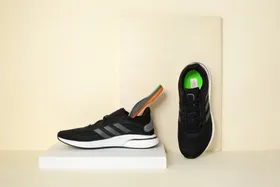The Best Orthotic Insoles for Sesamoiditis
Updated December 9, 2024

Sesamoids can be found in a variety of joints throughout the body and refer to a bone that's embedded in a tendon or muscle. In a healthy foot, the sesamoid is a two-headed bone embedded in a tendon in the ball of the foot beneath the big toe joint. When the sesamoid bone and surrounding tendons in the ball of the foot become infected, it's known as sesamoiditis.
This article looks at the symptoms and common causes of sesamoiditis as well as the best treatment options, with particular focus on the use of custom sesamoid orthotics.
Sesamoiditis Symptoms
Look out for the following possible sesamoiditis symptoms:
- Pain under the big toe
- Pain in the ball of the foot
- Difficulty bending the big toe
- Difficulty walking or carrying weight
- Swelling
- Redness
- Bruising
» Can your symptoms indicate another condition? Discover other possible causes of forefoot pain
Causes of Sesamoiditis
Sesamoiditis is frequently caused by overusing the tendons that interact with the sesamoid bones of the foot. The tendons can also get inflamed if they are subjected to frequent trauma. This includes wearing high heels or shoes that do not fit properly. If you have very high arches or flat feet, or walk with an inward roll, you can experience pain while walking. Additionally, sesamoiditis is also a rare side effect of gout.
You have a higher risk of developing sesamoiditis if you participate in sports or activities that place a lot of pressure on the ball of the foot, such as running, basketball, and ballet.
Can Orthotic Insoles Help Sesamoiditis?
To heal sesamoiditis, a mix of full-length custom orthotics and supportive footwear is frequently utilized. These are designed to redirect pressure away from the big toe joint rather than transferring it over the smaller toes toward the ball of the foot. Therefore, you can simplify how to choose insoles by testing whether it relieves the sesamoid bones of any excessive load or impact and provides shock absorption to avoid stress fractures.
Despite the fact that store-bought orthotics and over-the-counter sesamoiditis inserts claim to provide much-needed support, they are usually ineffective and actually cause more pain and discomfort. Sometimes, your pain is transmitted to another part of your body, giving you the impression that the insoles are working.
However, custom insoles or sesamoiditis orthotics take into account the individual structure of your foot and are made from high-quality, carefully selected materials. As a result, the quality of support provided by personalized orthotics is unparalleled. Upstep provides some of the best insoles that maximize comfort and effectiveness at a reasonable price.
Common Best Sesamoiditis Treatments:
- Rest Keep pressure off the injury until the symptoms subside.
- Restriction You can be advised to temporarily strap or tape the big toe. In more severe cases, a short leg fracture brace can be used to restrict movement.
- Elevation and ice Elevation and ice can aid in the reduction of inflammation.
- Therapy for soft tissues Therapeutic ultrasonography, moist heat, and soft tissue massages can aid in tissue rehabilitation.
- Physical therapy Physical therapy might help you regain range of motion if your foot has been immobilized by a brace or bandage.
- NSAIDs NSAIDs (non-steroidal anti-inflammatory drugs) can aid in the treatment of inflammation and pain.
- Steroid injections In rare, severe cases, steroid injections directly into the wounded tissue can reduce pain and inflammation.
- Surgery Surgery may be used as a last resort in rare cases of chronic sesamoiditis. Removing one (but not both) sesamoid bones may provide relief.
» Still struggling with sesamoiditis symptoms? Explore conservative treatments for sesamoiditis
Can Sesamoiditis Be Prevented With Proper Footwear?
In nutshell, wearing comfortable shoes, insoles, and custom orthotics and avoiding overtraining are the most effective ways to reduce the chance of developing sesamoiditis. This includes if you experience pain while exercising or if you find walking puts too much strain on your joints.
You can prevent the condition from worsening by wearing custom orthotics while walking or jogging. You can also implement various home remedies to combat symptoms. Remember to always seek medical help if your condition doesn't improve or if you have any questions.
» Where can you buy custom orthotics? Get your custom orthotics online








